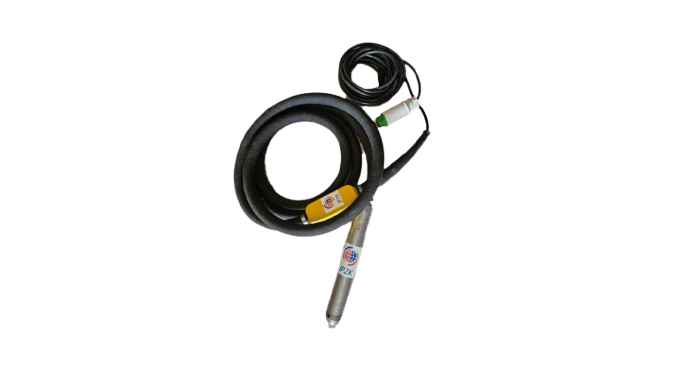Description
"Internal electric high frequency vibrators poker" refers to a specific type of construction equipment used primarily in concrete construction. Here's a breakdown of what each term typically means in this context:
Internal: These vibrators are designed to be inserted into the concrete mix. They are immersed or inserted internally within the concrete formwork or structure.
Electric: They are powered by electricity, often requiring a standard power outlet or a generator on site. Electric vibrators are preferred for their reliability and ease of use compared to other power sources like pneumatic (air-powered) or hydraulic systems.
High Frequency: Refers to the speed or frequency of vibrations produced by the equipment. High frequency vibrators typically operate at frequencies ranging from 10,000 to 17,000 vibrations per minute (vpm). This high frequency helps in efficiently compacting the concrete by dislodging air bubbles and enhancing the material's strength and consistency.
Vibrators Poker: The term "poker" is commonly used in Europe and other parts of the world to describe concrete vibrators. It essentially refers to the part of the equipment that is inserted into the concrete. The vibrating head or tip is sometimes called the poker head or vibrator head.
The High-Frequency (HF) Vibrator is an advanced concrete vibration tool designed to deliver rapid, powerful vibrations for efficient compaction of concrete in large-scale and high-performance construction projects. Unlike standard mechanical vibrators, HF vibrators operate at extremely high frequencies—typically between 12,000 to 17,000 vibrations per minute (vpm)—allowing for faster air bubble removal and a denser, more durable concrete finish. These vibrators are ideal for use in precast concrete plants, high-rise buildings, bridges, tunnels, and structures where precision and surface quality are paramount.
Technical Specifications
HF Vibrators are typically powered by an electrical converter or frequency generator, operating on 3-phase power (typically 42V, 200Hz) to achieve the desired vibration frequency. The vibrator head, usually made of high-strength steel, comes in various diameters ranging from 30 mm to 65 mm, depending on the application and the concrete volume. The vibrating needle length can extend from 1 m to 10 m, connected via durable, oil-resistant flexible hoses. The power rating of these machines usually falls in the 1.5 kW to 3.0 kW range, providing both power and reliability for extended operations. The system also includes thermal protection and overload safety mechanisms, ensuring safe and consistent operation even under tough site conditions.
Performance & Application
HF vibrators excel in applications where concrete needs to be compacted quickly and uniformly, minimizing segregation and honeycombing. Their high frequency ensures deep penetration and thorough compaction even in densely reinforced sections. This results in superior strength and long-term durability of the structure. They are particularly favored in precast yards, slab and beam construction, columns, retaining walls, and formwork applications. Many HF vibrators can also be integrated with automated vibration tables or form systems for continuous production environments.
User Advantages
The advantages of HF vibrators include faster compaction, better concrete finish, longer tool life, and lower maintenance needs. Since they run on electricity, they produce less noise and vibration fatigue for the operator compared to traditional petrol-driven vibrators. Their low maintenance design, along with easy-to-use control systems, makes them a smart investment for contractors aiming for high productivity and consistent quality.


 Brochure
Brochure Call Us
Call Us Whatsapp Now
Whatsapp Now